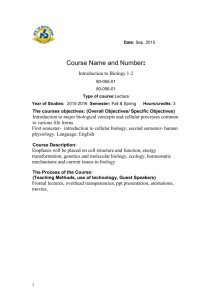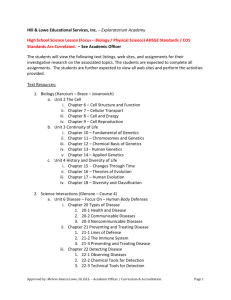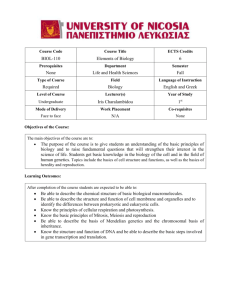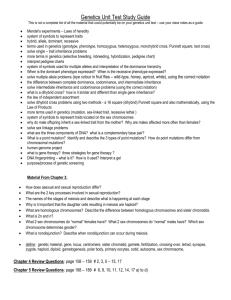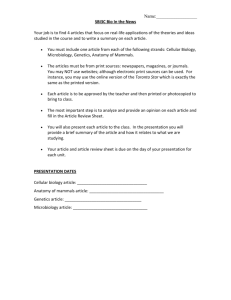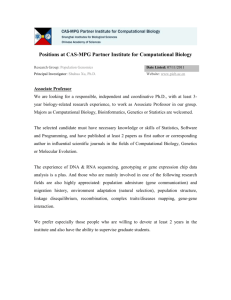Unit 2: Environmental Biology and Genetics
advertisement
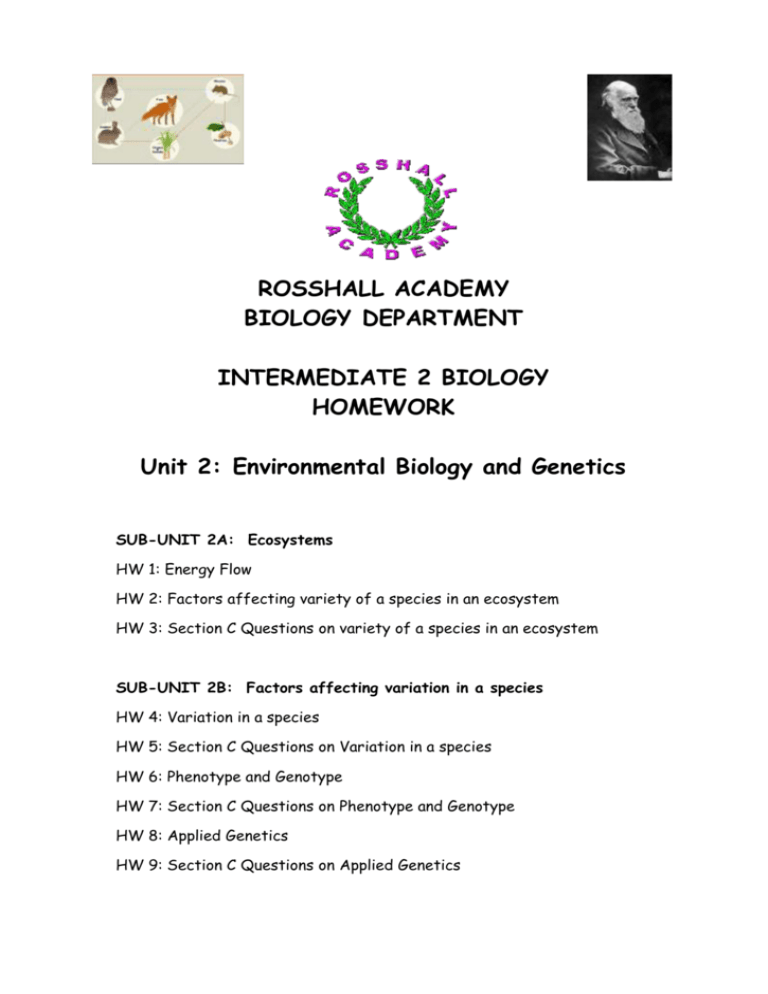
ROSSHALL ACADEMY BIOLOGY DEPARTMENT INTERMEDIATE 2 BIOLOGY HOMEWORK Unit 2: Environmental Biology and Genetics SUB-UNIT 2A: Ecosystems HW 1: Energy Flow HW 2: Factors affecting variety of a species in an ecosystem HW 3: Section C Questions on variety of a species in an ecosystem SUB-UNIT 2B: Factors affecting variation in a species HW 4: Variation in a species HW 5: Section C Questions on Variation in a species HW 6: Phenotype and Genotype HW 7: Section C Questions on Phenotype and Genotype HW 8: Applied Genetics HW 9: Section C Questions on Applied Genetics UNIT 2: ENVIRONMENTAL BIOLOGY AND GENETICS SUB-UNIT 2A: ECOSYSTEMS HOMEWORK 1: ENERGY FLOW Q1 The diagram below shows part of a food web from a moorland ecosystem. (i) Write each organism from the food web in the correct column in a table like the one below. Producer Primary consumer Secondary consumer 2 (ii) Describe one possible effect on the food web of a large increase in the grouse population. Q2 The song thrush feeds on snails which it finds by sight in a variety of habitats. Snails are herbivores and feed only on grasses. (a) (i) Present this feeding relationship as a food chain. (ii) Use the information above to complete a table like the one below. Term Organism 1 1 primary consumer predator prey producer 2 UNIT 2: ENVIRONMENTAL BIOLOGY AND GENETICS Q2 (continued) (iii) Describe what is meant by habitat. (b) (i) Name a decomposer and; (ii) Describe the role of decomposers in an ecosystem. Q3 The diagram shows part of a food web found on a rocky shore. (a) Use the words “increases”, “decreases”, or “stays the same” to suggest what might happen to the populations of barnacles and periwinkles if all the mussels were removed. GIVE A REASON FOR EACH ANSWER. (1) Barnacles (2) Periwinkle 1 1 1 1 1 (b) Why is biomass of algae greater than biomass of limpets? (c) The following diagram shows a pyramid of energy for part of the rocky shore ecosystem. The energy values are given in kJ/ m2/ year. Why does the energy value decrease from one level to the next? END OF HOMEWORK 1 1 1 UNIT 2: ENVIRONMENTAL BIOLOGY AND GENETICS HOMEWORK 2: FACTORS Q1 (a) AFFECTING VARIETY OF A SPECIES IN AN ECOSYSTEM The corncrake is a bird once found throughout the UK, but now mostly found in the north and west of Scotland. The decrease in corncrake numbers was caused by a change in hay cutting methods. Different farming methods were introduced from 1992 to save the corncrake. The following table shows the estimated numbers of adult corncrake males in Scotland from 1988 to 2001. Year Estimated number of adult males 1988 540 1990 485 1992 440 1994 470 1996 510 1999 590 2001 600 (i) Present the results as a line graph. 2 (ii) Describe the effect of the introduction of different farming methods on the corncrake population. 1 (b) The change in the corncrake population is the result of human activity. This affects biodiversity. Give one other example of a human activity that affects biodiversity and describe the effect. 1 (i) (ii) Human activity Effect on biodiversity 1 4 UNIT 2: ENVIRONMENTAL BIOLOGY AND GENETICS Q1 (continued) (c) The bar chart below illustrates biodiversity in three different meadows. 1 Which meadow has the lowest intensity of grazing? (d) Describe an adaptation of a desert plant and explain how this adaptation aids survival in desert conditions. 1 (i) (ii) Adaptation Explanation 1 [Turn over 5 UNIT 2: ENVIRONMENTAL BIOLOGY AND GENETICS Q2 The diagram below shows a section of a river. The table below shows the results of a survey into the oxygen content of the river at different sample points. Distance of sample from point X (m) Oxygen content (units) 0 1∙20 200 0∙04 500 0∙20 800 0∙40 1000 1∙00 (i) Construct a line graph of the results given in the table. 2 (ii) From the table calculate how many times greater the oxygen content is at 0 m than at 200 m. 1 (iii) Use data from the table to describe the relationship between oxygen content and distance of the sample from X. (iv) The number of micro-organisms were counted at each sample point and found to be highest 200 m from X. Account for the oxygen content of the river at 200 m. (b) State the effect of an increase in pollution on species diversity. 6 2 1 1 UNIT 2: ENVIRONMENTAL BIOLOGY AND GENETICS Q3 (a) (i) State one way that competition for food is reduced between zebras and giraffes. (ii) The Acacia tree is adapted to withstand long periods of drought. Suggest an adaptation the Acacia tree may show that allows it to survive long, dry periods. (b) Q4 In African grasslands impala, giraffe and zebra feed on Acacia trees. Impala and zebra also graze on grasses. In Scottish grasslands, sheep are often found as grazers. A very large flock of sheep was introduced into an area of ungrazed grassland. Explain why this would decrease biodiversity within this area. 1 1 2 Charles Darwin visited the Galapagos Islands. He found different species of finch on the different islands. The following gives information on the size and shape of beaks and the island habitats of two of the Galapagos finches. Size and shape of beak Habitat Long and narrow Rotting logs that provide food for insects Short and wide Trees and shrubs that provide seeds and nuts 1 (a) State which finch eats insects and give a reason for your answer. (b) Identify two ways in which competition between finch A and finch B is reduced. END OF HOMEWORK 2 7 2 UNIT 2: ENVIRONMENTAL BIOLOGY AND GENETICS HOMEWORK 3: SECTION C QUESTIONS ON VARIETY ECOSYSTEM OF A SPECIES IN AN 2002 1A The maps below show changes in the distribution of red squirrels in the UK from 1920 to 1990. (a) Describe the change in distribution between 1920 and 1990 (b) Suggest reasons for this change. (c) Discuss the potential impact this could have on biodiversity. 5 2004 2A Plants living in the desert are adapted for survival. Describe three adaptations and explain how each adaptation increases the chances of survival of the plant. END OF HOMEWORK 3 8 5 UNIT 2: ENVIRONMENTAL BIOLOGY AND GENETICS SUB-UNIT 2B: ECOSYSTEMS HOMEWORK 4: VARIATION IN A SPECIES Q1 The diagram below shows a yeast cell. (i) Name the structure shown in the yeast cell which contains the genetic information. (ii) A molecule consisting of chains of bases is contained in chromosomes. (A) Name this molecule. (B) Explain how this molecule controls cell activities. (b) Gamete production is essential to sexual reproduction. (i) Name the division of the nucleus that occurs during gamete production. Name the process occurring during this division that increases variation. Write out the sentence with one option in each set of brackets to make the following sentences correct. (ii) (iii) The number of chromosomes in gametes is found in body cells. The zygote is formed by fusion division half twice and contains the 1 2 1 1 1 number half twice the number of chromosomes in a gamete. [Turn over 9 1 2 UNIT 2: ENVIRONMENTAL BIOLOGY AND GENETICS Q2 (a) The diagram below shows meiosis and fertilisation in humans (i) Copy and complete the following table by naming the cells and stating the numbers of chromosomes present in each cell. Cell Name of cell A testis cell B sperm Number of chromosomes C 23 D 46 2 (ii) Describe what happens during fertilisation. 1 (b) (i) Name a structure in a cell which is composed of a chain of DNA bases. 1 (ii) Explain the importance of the order of the DNA bases to the functioning of a cell. 1 [Turn over 10 UNIT 2: ENVIRONMENTAL BIOLOGY AND GENETICS Q3 (a) Copy and complete the table to give the site of production and number of chromosomes of each type of gamete. Human gamete Site of production Number of chromosomes egg 2 sperm (b) The diagram below shows the chromosome complement of a cell about to divide to form gametes. (i) How many sets of chromosomes does this cell contain? (ii) Name the type of cell division which produces gametes. (iii) The following diagram shows one way in which these chromosomes may line up during cell division. Draw a diagram to show one other way in which the chromosomes may line up. (c) Chromosome pairs line up in a variety of ways. Explain why this random assortment is important. END OF HOMEWORK 4 11 1 1 1 1 UNIT 2: ENVIRONMENTAL BIOLOGY AND GENETICS HOMEWORK 5: SECTION C QUESTIONS ON VARIATION IN A SPECIES 2008 1A The diagram below shows a section through a flower. Name the sites of production of pollen grains and ovules in a flower. Describe how these gametes are formed and describe the process of fertilisation. 5 2002 1B The diagram below shows the two stages that result in the formation of offspring in animals (a) (b) Describe what happens in each stage. Explain how variation is brought about during each stage. 2000 2A Give an account of gamete formation in human females. 2004 2B Describe the structure of chromosomes. Explain how chromosomes determine the characteristics of an organism. END OF HOMEWORK 5 12 5 5 5 UNIT 2: ENVIRONMENTAL BIOLOGY AND GENETICS HOMEWORK 6: PHENOTYPE Q1 (a) AND GENOTYPE In peas the height of the plant is controlled by one gene which has two alleles. T represents the dominant allele for tall stems. True breeding, tall-stemmed pea plants were crossed with short-stemmed pea plants to produce the F1 generation. (i) State the genotype of each parent. 1 (ii) State the phenotypes of the F1 plants. 1 (iii) Plants from the F1 generation were crossed to produce the F2 generation of plants. State the phenotypes and their expected ratios in the F2 generation. (b) Seeds from true breeding, tall stemmed pea plants were provided with different growing conditions as shown in the diagrams below. (i) Compare the expected appearance of the plants in each group. (ii) What term is used to describe the effect of different conditions on the phenotype of an organism? 13 1 1 1 UNIT 2: ENVIRONMENTAL BIOLOGY AND GENETICS Q2 The diagram below shows the occurrence of tongue rolling in a family. (a) State the dominant form of the gene. 1 (b) Identify the individuals in the F1 generation. 1 (c) (i) Use the information in the diagram to copy and complete the table below. Individual Genotype A B Tt C G L Q3 TT (ii) Name an individual from the table who is heterozygous for the gene. (a) Name the male gametes and their site of production in a flower. (i) Male gametes (ii) Site of production 14 3 1 1 1 UNIT 2: ENVIRONMENTAL BIOLOGY AND GENETICS (b) Tomato plants were used in an experimental monohybrid cross. The parental phenotypes were cut leaf and potato leaf as shown in the diagram The parent plants were both true breeding. The F1 plants were self-pollinated. The F2 generation contained 80 plants with the cut leaf genotype and 20 plants with the potato leaf genotype. (i) Explain what is meant by the term true breeding. 1 (ii) State which characteristic is dominant and give a reason. 1 (iii) The results obtained in the F2 generation differ from the expected results. There were 100 plants in the F2 generation. Calculate the number of plants which would have been expected to have the cut leaf phenotype in the F2 generation. (iv) Suggest one reason why the results obtained differ from the expected results. [Turn over 15 1 1 UNIT 2: ENVIRONMENTAL BIOLOGY AND GENETICS Q4 In farmyard fowl, feather type is controlled by a single gene. The allele for normal feathers (N) is co-dominant with the allele for extreme frizzle feathers (F). The results of a cross between two homozygous fowl is shown below: (i) What would the genotypes of each parent be? (ii) Two mild frizzle fowl from the F1 were crossed together. Copy and complete the punnet square below to show the genotype of the gametes from the F1 male parent and the genotypes of the F2 produced. 1 genotype of gametes from F1 male parent genotype of gametes from F1 female parent (iii) N F 2 State the expected F2 phenotypic ratio (Normal : Mild frizzle : Extreme frizzle) 16 1 UNIT 2: ENVIRONMENTAL BIOLOGY AND GENETICS Q4 (continued) (b) Copy and complete the table below by writing the correct word from the list to match the description. Description List interbreeding A genotype with different alleles of a particular gene. recessive An allele which is always masked by a dominant allele. A type of cross between two true breeding parents that differ in one characteristic. heterozygous homozygous monohybrid (c) Word 3 Skin colour is an example of a human characteristic controlled by the alleles of more than one gene. What name is given to this type of inheritance? Q5 In humans the length of the big toe is controlled by a single gene which has two alleles. A father is homozygous for short big toe. A mother has long big toes. All of their children have short big toes. (a) Complete the following sentences by writing the correct word from each pair, using the information above. Long Short big toe is the dominant form of the gene. The mother is homozygous heterozygous and the children are all 17 1 1 homozygous heterozygous 1 UNIT 2: ENVIRONMENTAL BIOLOGY AND GENETICS Q5 (continued) (b) The ability to roll the tongue is controlled by another gene in humans. The allele for tongue rolling (R) is dominant to the allele for non rolling (r). The diagram below shows the occurrence of this tongue rolling gene. (i) With respect to the tongue rolling gene, state Jamie’s phenotype and Ben’s genotype. (1) Jamie’s phenotype (2) Ben’s genotype (ii) Kate has a son and his father is homozygous dominant for the characteristic. What is the percentage chance that the son is a tongue roller? (iii) State the two sex chromosomes present in Jill’s body cells. Q6 The diagram below shows all the chromosomes found in a human skin cell. 1 1 1 1 Identify the sex of the person and GIVE A REASON FOR YOUR ANSWER. 1 END OF HOMEWORK 6 18 UNIT 2: ENVIRONMENTAL BIOLOGY AND GENETICS HOMEWORK 7: SECTION C QUESTIONS ON PHENOTYPE AND GENOTYPE 2007 2B Describe the process of natural selection as illustrated by the peppered moth Biston betularia. 5 END OF HOMEWORK 7 HOMEWORK 8: APPLIED GENETICS Q1 (a) Organisms vary from one generation to the next. This variation may result from the following factors A B C Natural selection Selective breeding Environmental impact Use this information to copy and complete the table below. (Each letter may be used once, more than once or not at all.) Description Factor Produces changes not passed on to future generations Organisms that are better adapted to their surroundings survive and breed Effect of the surroundings on the final appearance of offspring Desirable characteristics chosen to produce improved offspring 19 2 UNIT 2: ENVIRONMENTAL BIOLOGY AND GENETICS Q1 (continued) (b) Arrange the following stages of genetic engineering in the correct order. (5 is the first stage) Stage number 1 2 3 4 5 Description of stage Bacterial cell produces insulin Insulin gene inserted into plasmid Plasmid removed from bacterial cell Plasmid inserted into bacterial cell Insulin gene removed from human chromosome (c) Give one advantage of genetic engineering. (d) The desert plant shown below has adaptations to survive in dry conditions. From the diagram give one adaptation which reduces water loss. Q2 The diagram below shows a genetically - engineered bacterial cell. (a) Name the type of molecule found in a bacterial chromosome. (b) The bacterium was genetically engineered to produce a particular substance. Name one example of a substance which can be produced in this way and describe its use. 20 1 1 1 1 1 UNIT 2: ENVIRONMENTAL BIOLOGY AND GENETICS Q2 (continued) (c) Genetic engineering can produce new genotypes to provide better organisms for particular functions. Give one advantage and one disadvantage of genetic engineering compared with selective breeding. 1 Q3 (i) (ii) Advantage Disadvantage (a) The table below gives information about wheat produced by selective breeding over many generations. 1 Generation number Average height of stem (cm) Grain yield (tonnes per hectare) Average length of grain (mm) 1 142 6∙0 10 27 126 6∙0 9 45 110 6∙7 11 64 106 7∙5 11 72 84 8∙7 10 From the table, describe one improvement in the wheat and explain why it is a desirable characteristic. (i) Improvement (ii) Explanation (b) Give one disadvantage of selective breeding. (c) Genetic engineering can be used to transfer human genes to bacteria. Name a human hormone which can be produced by genetically engineered bacteria. END OF HOMEWORK 8 21 2 1 1 UNIT 2: ENVIRONMENTAL BIOLOGY AND GENETICS HOMEWORK 9: SECTION C QUESTIONS ON APPLIED GENETICS 2005 1A The diagram below shows some characteristics of two present day breeds of dog which descended from a wolf-like common ancestor. Name and describe the process which humans have used to produce different breeds of dog 5 2005 1B The diagram below shows the two different forms of the peppered moth Biston betularia on the bark of a tree located in an unpolluted area. Name and describe the process by which the black form of the moth became the most common form in polluted areas in Scotland. 22 5 UNIT 2: ENVIRONMENTAL BIOLOGY AND GENETICS 2007 2A Genetic engineering uses bacteria to produce human insulin. Describe the stages involved in this process. 5 2007 2B Describe the process of natural selection as illustrated by the peppered moth Biston betularia. 5 2008 1B The diagram below summarises a form of genetic engineering. Identify cell type A and name a product of genetic engineering. Describe the advantages and disadvantages of this process. END OF HOMEWORK 9 23 5
